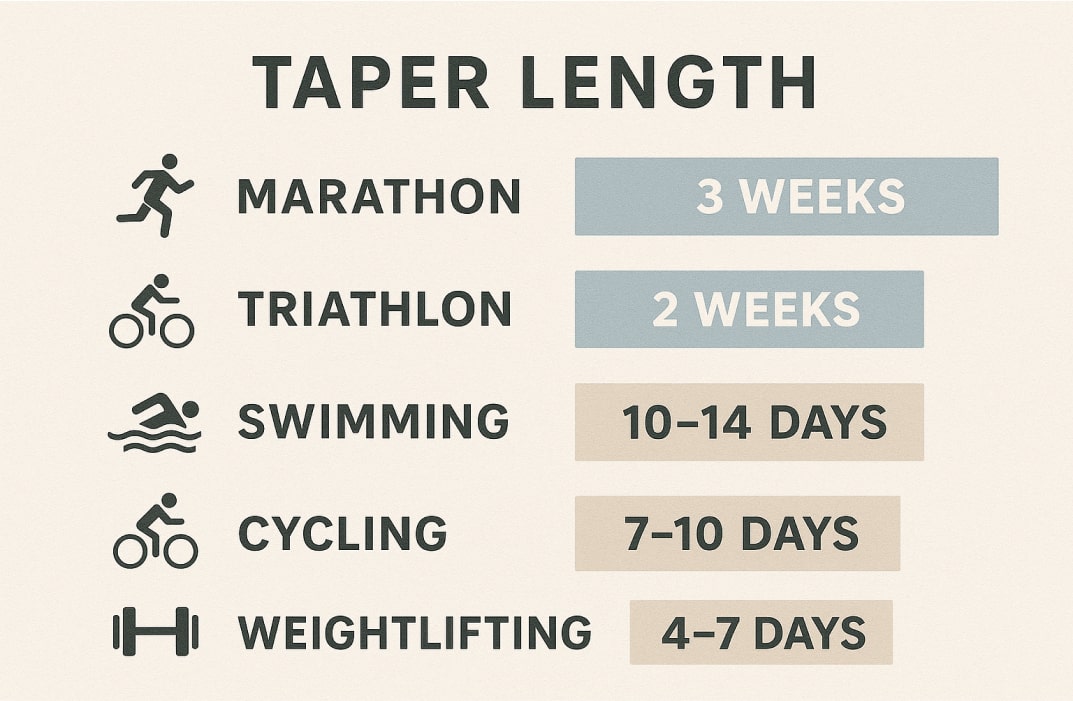If you’ve ever prepared for a big race, marathon, or sports competition, you’ve probably heard the term tapering. But what does tapering mean, and why do coaches emphasize it so much before the big day?
In simple words, tapering means gradually reducing your training volume, intensity, and frequency so your body can recover, rebuild, and perform at its absolute best. Think of it as hitting the brakes at just the right point—slowing down, not because you’re giving up, but because you’re preparing to go faster when it matters most.
Taper Definition in Sports:
- A taper is the planned, gradual decrease in exercise before an important event.
- The tapering period can last from a few weeks to even a month, depending on the training program, length of event, and competition goals.
- The goal is simple: create the perfect balance between recovery and performance.
So, what is the taper in practical terms? Imagine you’ve been pushing hard for months with long runs, intense workouts, and strict routines. The first step of tapering is to slightly reduce your workload, letting your body adapt, store energy, and prepare for competition. This way, when you finally reach the starting line, you feel fresh, strong, and fully ready.
Tapering Training: Definition and Meaning
Now that we’ve covered the basics, let’s dive deeper into the definition of tapering and what it really means for athletes.
So, what is tapering in training? At its core, tapering is the planned reduction of training load before a big event. This reduction usually involves cutting down volume, intensity, or frequency while still maintaining enough movement to keep the body sharp. In other words, tapering allows you to “do less, but achieve more.”
Some people confuse terms like taper def, tapering meaning, or exercise taper, but they all point to the same concept—training smarter, not harder, before competition.
Here’s how different terms related to tapering are often used:
As you can see, the tapering definition can vary slightly depending on the sport, but the principle remains the same: a gradual decrease in training that allows athletes to perform at their peak when it matters.
In fact, sports scientists often say that the tapering period is like a secret weapon. While some athletes fear losing fitness during this time, research shows that when done correctly, tapering leads to better recovery, improved form, and higher performance levels.
How Does Tapering Work? (The Science of the Taper)

If you’re still wondering “what does tapering mean in sports?”, the answer lies in how your body responds to training stress. Training pushes your body to its limits, but recovery is where true progress happens. That’s where the tapering period comes in—it’s all about striking the perfect balance between exercise, recovery, and performance.
The Science Behind the Taper
When you reduce your training volume and intensity, a few important things happen inside your body:
- Muscle Recovery: Tapering allows your muscles to repair from months of hard training.
- Energy Storage: Glycogen (your body’s energy fuel) is replenished, so you don’t hit the wall during competition.
- Hormonal Response: Stress hormones decrease while growth and recovery hormones increase.
- Performance Boost: With less fatigue and more energy, your body feels fresh, sharp, and competition-ready.
In short, tapering means gradually reducing the workload to let your body supercompensate—recover beyond its usual state—so you perform better on race day.
How the Taper Works in Practice
Think of it like a curve:
- At the beginning of tapering, you slowly cut down the workload.
- Over weeks, training volume continues to drop, while intensity is maintained at just the right level.
- By the end of the taper, your body has adapted, recovered, and is primed for peak performance.
Here’s a simple breakdown:
This is why athletes often say, “The taper is where champions are created.” It’s not just about doing less; it’s about doing the right amount at the right time.
Benefits of Tapering Training
So now that we know what tapering is and how it works, let’s talk about the real question—why should you taper? The truth is, the benefits of tapering go far beyond just feeling rested. Done right, tapering can make the difference between an average performance and a personal best.
Physical Benefits of Tapering
- Better Recovery: Your muscles and joints finally get the chance to heal from weeks (or even months) of hard work.
- Energy Boost: Tapering allows glycogen levels to refill, giving you more fuel on race day.
- Injury Prevention: By lowering training stress, tapering reduces the risk of overuse injuries.
Mental Benefits of Tapering
- Sharper Focus: With less fatigue, your concentration improves.
- Confidence Builder: Knowing you’re fresh and ready makes you feel unstoppable.
Reduced Stress: The tapering period gives your mind a break, not just your body.
Table: Benefits of Tapering Training
“The tapering period is not about doing less—it’s about creating the conditions to achieve more.”
Also read: Plant-Based Diets for Athletes
Why Coaches Trust the Taper
Most top athletes and coaches agree that tapering is the first step toward achieving peak form. Even a 2–3 week taper can lead to noticeable improvements in performance, pace, and recovery. In fact, studies show that tapering can improve endurance performance by up to 3–5%.
And here’s where FitBudd comes in: tapering works best when it’s personalized. With tools like FitBudd’s personal training software, athletes and coaches can track training volume, plan taper phases, and monitor recovery—ensuring every taper is designed for maximum performance.
How Long Does a Taper Last?

One of the most common questions athletes ask is: “How long does a low taper last?” The answer is—it depends. The length of tapering is influenced by the sport, training volume, competition goals, and even the individual athlete’s recovery response.
Typical Taper Duration
- For most endurance sports like a marathon or triathlon, the taper usually lasts 2–3 weeks.
- For shorter events like sprints or weightlifting, the taper might be just 7–10 days.
- Some athletes use a low taper (shorter, around a week), while others prefer a long taper (3–4 weeks).
A helpful way to think about it: the longer the race or competition, the longer the taper period typically needs to be.
Table: Taper Duration Across Sports
Remember: tapering doesn’t mean stopping. It means doing just enough to stay sharp while allowing your body to recover.
Example: Marathon Taper
- Week 1: Reduce weekly mileage by 20–30%.
- Week 2: Cut mileage by 40–50%, keep some pace work.
- Race Week: Short runs only, focus on rest, nutrition, and mental prep.
Tapering in Different Sports

While the definition of tapering remains the same across disciplines, the way athletes apply it can look very different. A marathon runner’s taper doesn’t look the same as a swimmer’s, and a strength athlete preparing for a weightlifting meet will taper differently than a triathlete.
Understanding how tapering applies to specific sports helps you see why it is such a powerful tool for performance.
Tapering for Marathon Training
In marathon preparation, tapering is crucial. After months of long runs and high mileage, the tapering period allows runners to reduce mileage gradually while keeping some intensity. This strategy ensures that glycogen levels are restored, muscles are fresh, and mental energy is high on race day.
Tapering in Strength Training
For strength athletes, tapering means reducing training volume—fewer sets and reps—while maintaining intensity to keep the muscles firing at full capacity. The goal is to avoid fatigue while staying strong for the competition platform.
Tapering in Swimming
Swimmers often use a shorter taper, typically 1–2 weeks. Workouts remain intense but shorter, ensuring swimmers feel light, fast, and powerful in the water.
Tapering in Triathlon
Triathletes have to balance three sports—swimming, cycling, and running—so their taper focuses on a balanced reduction in total training volume while maintaining form and rhythm in each discipline.
Tapering in Cycling
Cyclists taper by cutting back on weekly mileage but maintaining sharp efforts like sprints or intervals. This keeps the legs fresh while preventing fatigue before a race.
Comparison Table: Sport-Specific Tapering
The common thread across all sports is the same: tapering is about reducing workload without losing sharpness. It ensures that whether you’re running a marathon, lifting weights, or diving into the pool, your body is in the best possible condition to perform.
Signs You’re Tapering Correctly
Tapering is more than just reducing training; it’s about preparing your body and mind to perform at peak levels. But how do you know if your taper is working? Recognizing the signs of an effective taper helps athletes avoid overtraining, undertraining, or losing fitness.
Physical Signs
- Reduced Muscle Fatigue
During a proper taper, your muscles feel lighter, less sore, and more responsive. You may notice that workouts feel easier than during heavy training weeks, even at similar intensity. - Improved Energy Levels
One of the clearest signs of a successful taper is increased overall energy. You’ll feel more alert during training sessions and daily activities because your body has had time to recover. - Faster Recovery
Recovery between workouts should be noticeably quicker. If you can train hard in shorter sessions without lingering soreness, your taper is working as intended. - Better Sleep
During tapering, many athletes notice improved sleep quality. Deep, restorative sleep helps the body repair muscles, restore glycogen, and regulate hormones, all essential for peak performance.
Mental Signs
- Heightened Focus and Confidence
A successful taper not only benefits your body but also your mind. Athletes often report feeling more confident and mentally sharp during this period, ready to tackle race day or competition. - Lower Stress and Anxiety
Reduced training load lowers overall stress, helping athletes feel calmer and more positive. This mental clarity can make a big difference in race strategy and performance. - Motivation and Excitement
Proper tapering often restores enthusiasm for training. If you feel excited to hit workouts and competition day, it’s a strong indicator your taper is effective.
Signs of Effective vs Ineffective Tapering
Practical Tapering Guidelines for Athletes

Knowing the definition of tapering is one thing, but applying it in real life is where the results happen. The truth is, there isn’t a one-size-fits-all taper.
Every athlete’s taper will depend on their training volume, sport, competition goals, and recovery needs. Still, there are some proven guidelines that can help you design a tapering period that works.
First Step to Tapering Training
The first step is to gradually reduce your workload. Typically, athletes cut down training volume by 40–60% while keeping intensity at about 70–80% of normal. This ensures that your body gets enough rest without losing sharpness.
Do’s of Tapering
- Reduce overall training volume but keep short bursts of intensity.
- Maintain a consistent training frequency (don’t stop completely).
- Use the extra time for recovery strategies like stretching, sleep, and proper nutrition.
- Stay mentally sharp by rehearsing race strategy or visualizing success.
Don’ts of Tapering
- Don’t overdo it—training harder during taper defeats the purpose.
- Don’t cut out intensity entirely; otherwise, you risk feeling sluggish.
- Don’t try new exercises or training methods during the tapering period.
- Don’t ignore nutrition; tapering works best when paired with proper fueling.
Example: A Simple Tapering Plan for a Runner
- Week 1: Drop mileage by 20–30%, keep one moderate-intensity run.
- Week 2: Cut mileage by 40–50%, focus on shorter, sharper runs.
- Race Week: Reduce to light jogging, prioritize rest and recovery.
FitBudd Tip: Personalized Tapering Made Simple
Every athlete responds to tapering differently, which is why tracking progress is important. With FitBudd, coaches and athletes can:
- Track training volume and intensity over weeks.
- Adjust taper schedules based on performance response.
- Get reminders and insights to avoid doing too much—or too little.
This makes tapering less about guesswork and more about creating a smart, personalized plan that leads to peak performance.
Common Mistakes During Tapering
.jpg)
The Power of Tapering Training
While tapering sounds simple—just train less—it’s easy to get it wrong. Many athletes misunderstand what tapering means, and as a result, they either reduce too much or not enough. Both mistakes can hurt performance on race day.
Mistake 1: Cutting Too Much
Some athletes think tapering means stopping almost all exercise. But a taper isn’t about becoming inactive. If you cut too much, you may feel sluggish, slow, and out of form when it’s time to compete.
Mistake 2: Training Too Hard
On the other end of the spectrum, some athletes panic and increase intensity during taper, worried about “losing fitness.” This is a classic error. Overdoing it during the tapering period leads to fatigue and poor recovery, leaving you drained when it matters most.
Mistake 3: Ignoring Nutrition and Recovery
Tapering works best when paired with proper nutrition, hydration, and sleep. If you reduce training but don’t fuel or rest properly, you won’t get the full benefit of tapering.
Mistake 4: Last-Minute Changes
Trying a new training style, changing your running shoes, or switching up form during taper is risky. The taper is about stability—letting your body adapt, not creating new stress.
What Does Tapering Mean If Done Wrong?
If tapering is done incorrectly, it defeats its entire purpose. Instead of feeling fresh, athletes may feel tired, anxious, or even flat. The result: decreased performance rather than the peak form tapering is meant to achieve.
Quick Checklist to Avoid Mistakes
- Keep training, but reduce volume and frequency gradually.
- Maintain some intensity—don’t let your pace drop too much.
- Stick to familiar routines and recovery strategies.
- Focus on consistency, not experimentation.
The Power of Tapering Training

By now, it’s clear that tapering is far more than just a rest period. It’s a carefully planned strategy that helps athletes recover, recharge, and perform at their very best. Whether you’re preparing for a marathon, triathlon, weightlifting competition, or swim meet, the definition of tapering stays the same: a gradual decrease in training load to create peak readiness.
The benefits of tapering are both physical and mental—stronger recovery, more energy, better focus, and reduced injury risk. But tapering only works when it’s done right. Cut too much, and you may lose sharpness. Train too hard, and you risk showing up fatigued. The key is balance.
And here’s the good news: you don’t have to manage it all on your own. With FitBudd, athletes and coaches can easily design taper plans, track training volume, and monitor recovery to make sure every taper is optimized. It’s about creating smart, data-driven adjustments that lead to confidence and performance on competition day.
So the next time you hear someone ask, “What is tapering?”, you’ll know the answer: it’s the secret weapon that helps athletes turn months of hard work into results.
FAQs
1. What does tapering mean in training?
Tapering means gradually reducing training volume, intensity, and frequency before a competition. It helps athletes recover, store energy, and maintain form and pace for peak performance.
2. How long does a low taper last?
A low taper usually lasts 1–2 weeks, but for longer events like marathons, it can extend up to 3–4 weeks. Duration depends on training load, sport type, and goals.
3. What is the taper in running?
In running, the taper is the phase before a race where mileage and training load are gradually decreased. It helps runners feel fresh while maintaining speed and running form.
4. What are the benefits of tapering?
Tapering improves recovery, energy levels, mental focus, and reduces injury risk. Done correctly, it allows athletes to perform at their best on race or competition day.
5. What does tapering mean for strength training?
Strength athletes reduce sets and reps while keeping intensity during tapering. This ensures muscles remain strong and fresh for competitions without causing fatigue.
6. What is a tapered workout?
A tapered workout is a lighter, shorter session during tapering. It keeps your exercise form, technique, and pace sharp while preventing fatigue.
7. Can you lose fitness during tapering?
No, if done correctly. Tapering maintains fitness and performance while reducing fatigue. Many athletes even experience a 2–6% boost in performance after a proper taper.
8. What does taper all around mean?
“Taper all around” means reducing training volume, intensity, and frequency across all workouts while focusing on recovery, nutrition, and mental prep.
9. Does tapering help prevent injuries?
Yes. By reducing overuse stress on muscles and joints, tapering lowers injury risk. Athletes arrive at competition stronger and safer.
10. How should I adjust my pace during a taper?
During tapering, maintain short bursts at race pace but reduce overall mileage or sets. This keeps the body ready without adding fatigue.
11. Can beginners benefit from tapering?
Absolutely. Even new athletes gain from tapering. It helps the body adapt to training, recover fully, and feel confident before their first race or fitness event.
12. What is the best way to taper for a marathon?
For marathon runners, gradually reduce weekly mileage by 20–60% over 2–3 weeks. Keep a few short, faster-paced runs to maintain speed and rhythm.
13. Can tapering improve mental performance?
Yes. Tapering reduces training stress, allowing athletes to focus mentally, boost confidence, and feel prepared for competition or race day.
14. How do coaches monitor tapering effectively?
Coaches track training volume, intensity, and recovery to ensure the taper is effective. Tools like FitBudd can help plan taper schedules and monitor athlete readiness.
92% trainers worldwide gave us 5 stars
Talk to your dedicated success manager and launch your branded fitness app during the demo in minutes.
Start your paid subscription for $79 FREE





%20to%20Become%20a%20Certified%20Personal%20Trainer-min.jpg)





